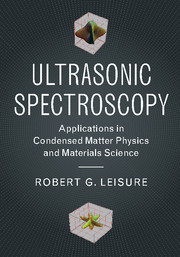Book contents
- Frontmatter
- Contents
- Preface
- 1 Introduction
- 2 Elasticity
- 3 Acoustic Waves in Solids
- 4 Experimental Methods
- 5 Elastic Constants
- 6 Ultrasonic Loss
- Appendix A Phase Shifts Due to Transducers and Bonds
- Appendix B Diffraction
- Appendix C Transducer Effects on Resonant Frequencies
- Appendix D Damped, Driven Oscillator and Complex Force Constant
- Appendix E Comparison of the Quasistatic and Experimental Temperature Dependence for Specific Cases
- References
- Index
4 - Experimental Methods
Published online by Cambridge University Press: 19 June 2017
- Frontmatter
- Contents
- Preface
- 1 Introduction
- 2 Elasticity
- 3 Acoustic Waves in Solids
- 4 Experimental Methods
- 5 Elastic Constants
- 6 Ultrasonic Loss
- Appendix A Phase Shifts Due to Transducers and Bonds
- Appendix B Diffraction
- Appendix C Transducer Effects on Resonant Frequencies
- Appendix D Damped, Driven Oscillator and Complex Force Constant
- Appendix E Comparison of the Quasistatic and Experimental Temperature Dependence for Specific Cases
- References
- Index
Summary
The discussion of experimental methods has been deferred until this point, because relevant background material was covered in Chapters 2 and 3. The usual experimental objectives are to determine one or both of the following quantities: 1. The elastic constants or, equivalently, the ultrasonic velocities; and 2. The dissipation or loss. The second property is known by several names, often depending on the method of measurement – ultrasonic attenuation, internal friction, logarithmic decrement, inverse Q, etc. Many different experimental techniques have been developed over the years, and there are various ways to categorize them. One possible approach is to divide the different methods into continuous wave techniques, in which a standing wave resonance is set up in the specimen, and pulse methods in which a short pulse of ultrasound is sent through the specimen, sometimes called the pulse-echo technique. However, when considering the problems of sample preparation and orientation, transducers, and corrections for non-ideal experimental configurations, it seems better to divide the methods into: 1. plane-wave propagation methods; and 2. methods not based on the plane-wave approximation.
In the discussion to follow, a few seminal papers will be cited, but the emphasis will be on modern techniques. It is not possible to cite the many, many scientists who have contributed to the development of the present-day methods.
Plane-Wave Propagation Methods
The plane-wave propagation methods are divided naturally into pulse techniques and continuous wave (resonance) techniques. After a short discussion of common problems, the pulse and resonance methods will be discussed separately below.
Figure 4.1 shows a typical sample-transducer arrangement used in the planewave propagation methods. Configurations with a single transducer, the same one being used for transmitting and receiving, are also used. The specimen is prepared with flat and parallel end faces. The transducers, which convert electrical voltages to mechanical displacements and vice-versa, are usually specially oriented cuts of piezoelectric materials and are commercially available. Single-crystal quartz, PZT, and lithium niobate are common transducer materials. Polyvinylidene fluoride (PVDF) piezoelectric film transducers have also been used [68].
- Type
- Chapter
- Information
- Ultrasonic SpectroscopyApplications in Condensed Matter Physics and Materials Science, pp. 94 - 119Publisher: Cambridge University PressPrint publication year: 2017



